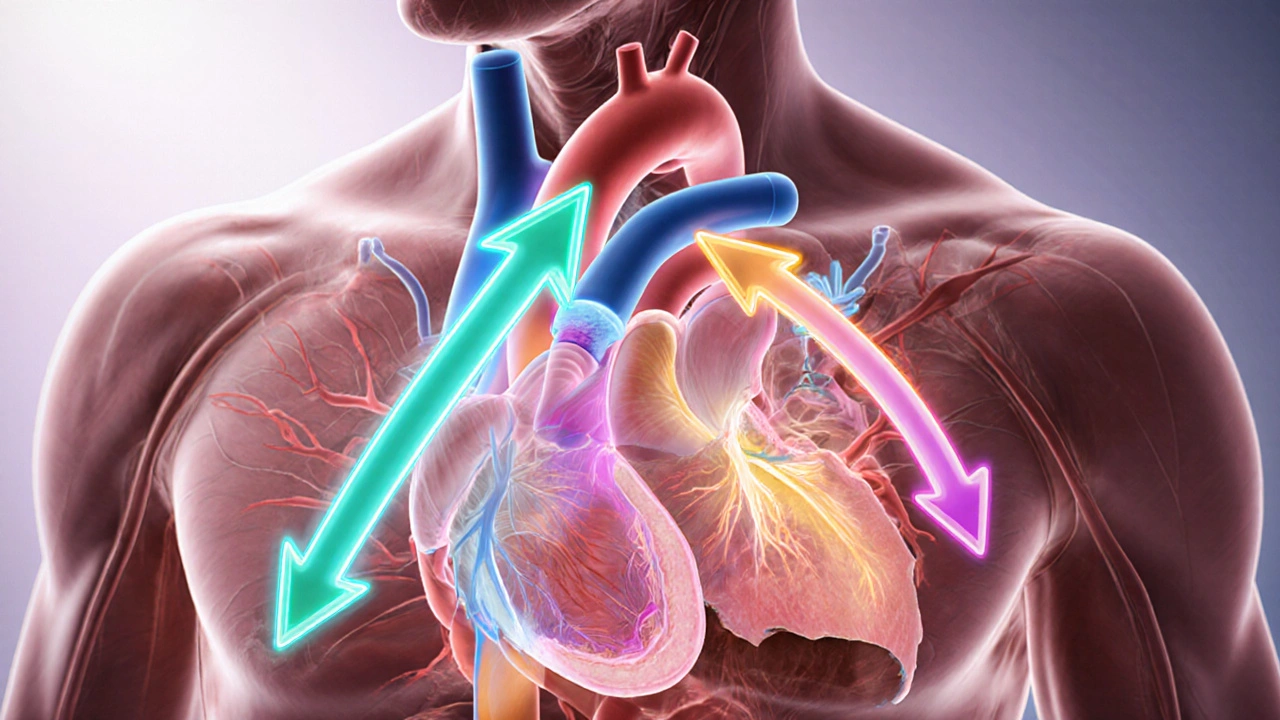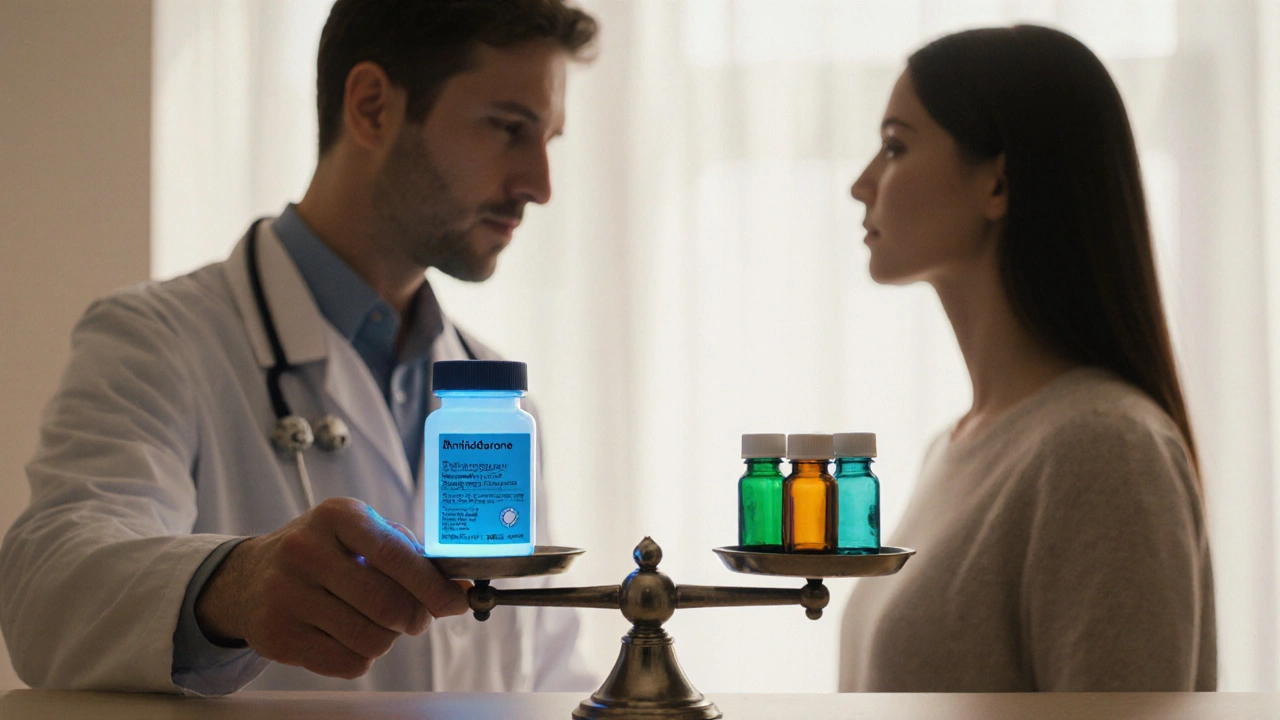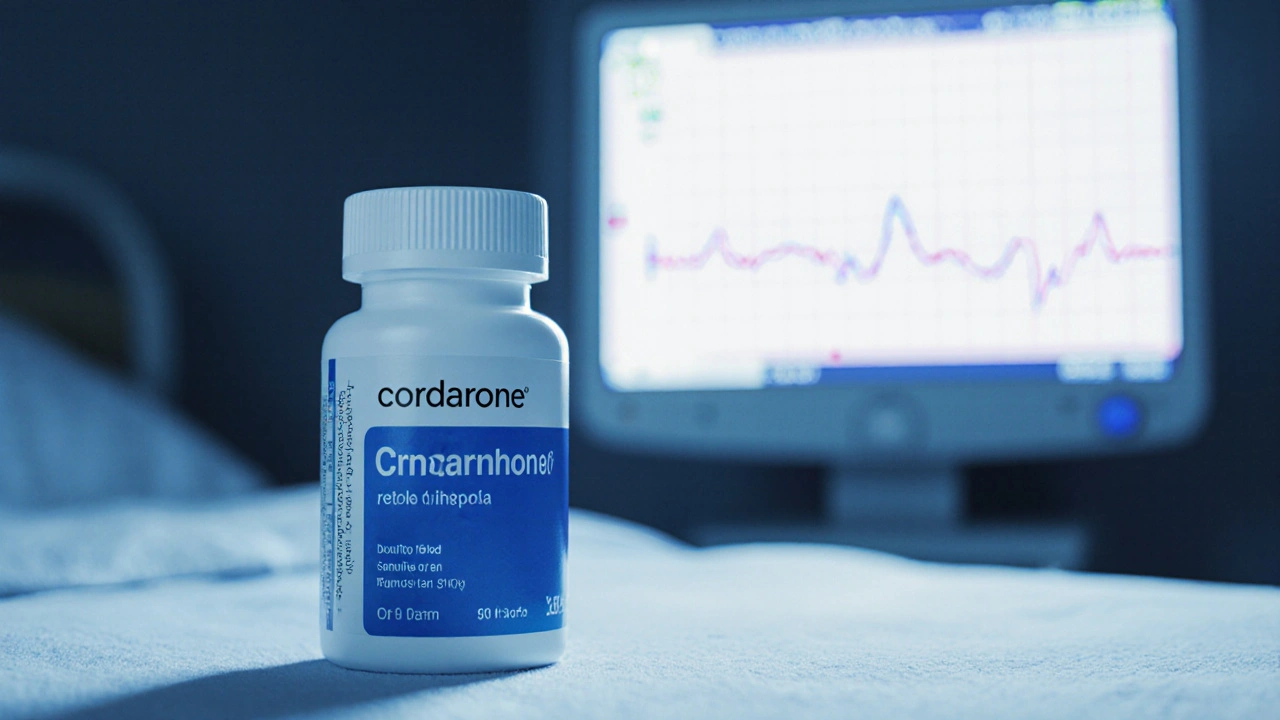Anti-Arrhythmic Drug Selector
Quick Takeaways
- Amiodarone is highly effective for many arrhythmias but carries a broad side‑effect profile.
- Sotalol and dronedarone are safer for long‑term use but less potent in severe ventricular tachycardia.
- Cost and monitoring needs differ widely - amiodarone is cheap but requires regular lab work.
- Patient comorbidities (thyroid, lung, liver) often dictate which drug is appropriate.
- Discuss with your cardiologist; a tailored choice beats a one‑size‑fits‑all approach.
What is Cordarone (Amiodarone)?
When you first see Cordarone is a brand name for amiodarone, a class III anti‑arrhythmic medication used to restore and maintain normal heart rhythm. It was approved in the United States in 1985 and quickly became a go‑to drug for atrial fibrillation (AF) and ventricular tachycardia (VT) because of its strong rhythm‑stabilizing effect.
Amiodarone works by blocking potassium channels, which prolongs the cardiac action potential. It also has modest sodium, calcium, and beta‑blocking activity, giving it a “multi‑channel” profile that explains its broad efficacy.
When is Amiodarone Typically Prescribed?
Doctors reserve amiodarone for patients who have failed or cannot tolerate other anti‑arrhythmics, or when the arrhythmia is life‑threatening. Common scenarios include:
- Refractory atrial fibrillation or flutter.
- Sustained ventricular tachycardia, especially in structural heart disease.
- Patients with an implanted cardioverter‑defibrillator (ICD) needing pharmacologic backup.

Major Side Effects and Monitoring
Amiodarone’s downside is a long list of possible toxicities because the drug accumulates in fat and many organs. Key concerns are:
- Pulmonary toxicity - can lead to fibrosis; occurs in 5‑10% of long‑term users.
- Thyroid dysfunction - both hypo‑ and hyper‑thyroidism due to iodine content.
- Hepatotoxicity - liver enzymes rise in up to 20% of patients.
- Skin discoloration and photosensitivity.
- Corneal deposits - usually harmless but can affect vision.
Because of these risks, physicians order baseline chest X‑ray, liver function tests, thyroid panels, and then repeat them every 3‑6 months.
Common Alternatives to Amiodarone
Below are the most frequently considered drugs when clinicians look for an alternative. Each entry includes a microdata definition for easy knowledge‑graph mapping.
Sotalol is a class III anti‑arrhythmic that also blocks beta‑adrenergic receptors, making it useful for atrial fibrillation and some ventricular arrhythmias.
Dofetilide is a pure potassium‑channel blocker, approved for conversion of atrial fibrillation and for maintenance of sinus rhythm.
Flecainide is a class Ic agent that works by blocking fast sodium channels, often chosen for “pill‑in‑the‑pocket” conversion of AF.
Propafenone shares a similar mechanism with flecainide but adds mild beta‑blocking activity.
Dronedarone is a structural analogue of amiodarone designed to reduce organ toxicity while retaining rhythm‑control benefits.
Procainamide is a class Ia anti‑arrhythmic that blocks sodium channels and is sometimes used for ventricular tachycardia in patients without structural heart disease.
Lidocaine is an IV class Ib agent, primarily employed for acute ventricular arrhythmias during myocardial infarction.
Side‑Effect Snapshots of the Alternatives
- Sotalol - risk of torsades de pointes; requires QT monitoring.
- Dofetilide - also torsades risk; must be initiated in hospital with renal dosing adjustments.
- Flecainide/Propafenone - contraindicated in structural heart disease; may cause pro‑arrhythmia.
- Dronedarone - less pulmonary and thyroid toxicity but less effective in heart‑failure patients.
- Procainamide - can cause lupus‑like syndrome and hypotension.
- Lidocaine - neurotoxicity and bradycardia at high plasma levels.

Head‑to‑Head Comparison Table
| Drug | Primary Indication | Mechanism | Typical Dose | Major Side Effects | Contraindications | Cost (US$ per month) |
|---|---|---|---|---|---|---|
| Amiodarone | Refractory AF, VT, VF | Multi‑channel (K+, Na+, Ca2+, β) | 200‑400mg daily after loading | Pulmonary fibrosis, thyroid disorder, liver injury, skin photosensitivity | Severe sinus node disease, iodine allergy | ~$15 |
| Sotalol | AF, non‑sustained VT | K+ channel block + β‑blocker | 80‑160mg BID | QT prolongation, torsades, bronchospasm | Second‑degree AV block, severe asthma | ~$30 |
| Dofetilide | AF conversion/maintenance | Selective K+ block | 125‑500µg BID (renal‑adjusted) | Torsades, renal impairment | QT >500ms, severe CKD | ~$120 |
| Flecainide | ‘Pill‑in‑the‑pocket’ AF | Fast Na+ block | 50‑300mg QD (or PRN) | Pro‑arrhythmia in CAD, dizziness | Structural heart disease, CAD | ~$45 |
| Dronedarone | Paroxysmal AF, sinus rhythm maintenance | Multi‑channel, less iodine | 400mg BID | Hepatotoxicity, GI upset, modest QT prolongation | NYHA Class IV HF, permanent AF | ~$250 |
| Procainamide | VT (no structural disease) | Na+ block (Class Ia) | 250‑500mg Q4‑6h IV/PO | Lupus‑like syndrome, hypotension | Severe cardiac disease, lupus | ~$65 |
| Lidocaine | Acute VT during MI | Na+ block (Class Ib) | 1‑1.5mg/kg IV bolus, then infusion | Neurotoxicity, bradycardia | Severe hepatic failure | ~$25 (hospital use) |
How to Choose the Right Anti‑arrhythmic
Deciding between amiodarone and its alternatives boils down to three questions:
- What is the underlying heart condition? If the patient has heart failure, amiodarone often remains the safest option because many alternatives worsen contractility.
- How long will the medication be needed? For short‑term conversion, drugs like flecainide or procainamide are attractive; for chronic therapy, sotalol or dronedarone may be preferred.
- What comorbidities exist? Thyroid disease, pulmonary issues, or renal impairment tip the scales toward a less toxic drug.
In practice, a cardiologist will start with the most effective drug (often amiodarone) and then switch if side effects appear or if the patient’s profile changes.
Practical Tips for Patients on Amiodarone or Its Alternatives
- Keep a medication diary - note any new cough, weight gain, or vision changes.
- Never stop amiodarone abruptly; taper under medical supervision to avoid rebound arrhythmia.
- Stay up‑to‑date on lab work - the frequency may reduce after the first year if results stay stable.
- Discuss drug interactions - many antibiotics, antifungals, and statins raise amiodarone levels.
- Ask about sunscreen - photosensitivity is real for amiodarone and dronedarone.
Frequently Asked Questions
Can I take amiodarone and sotalol together?
Combining two class III drugs greatly raises the risk of QT prolongation and torsades. Doctors only use a short‑term overlap when switching, and they monitor the ECG closely.
Why is dronedarone marketed as a safer amiodarone?
Dronedarone removes the iodine-rich aromatic ring that causes most of amiodarone’s thyroid and lung toxicity. The trade‑off is slightly weaker rhythm control, especially in patients with advanced heart failure.
How long does it take for amiodarone side effects to appear?
Pulmonary toxicity often emerges after 6‑12months of continuous therapy, while thyroid changes can show up within a few weeks to several months. Regular monitoring catches problems early.
Is flecainide safe for someone with a prior heart attack?
No. Flecainide is contraindicated in any patient with structural heart disease, including prior myocardial infarction, because it can trigger dangerous ventricular arrhythmias.
Do insurance plans usually cover the cheaper amiodarone?
Yes, generic amiodarone is widely covered and costs a fraction of newer agents. However, some plans require prior authorization for long‑term use because of the monitoring burden.
Choosing the right rhythm‑control drug isn’t a lottery; it’s a balance of efficacy, safety, cost, and individual health factors. Use the table above as a starting point, talk openly with your cardiology team, and keep an eye on the labs. That way you get the heart‑steady benefits without paying a price you didn’t bargain for.


Ryan Hlavaty
Anyone who believes they can prescribe amiodarone without weighing the heavy side‑effect burden is flirting with negligence. The drug’s pulmonary and thyroid toxicity demand rigorous monitoring, and treating it as a cheap fix shows a careless attitude toward patient safety. It’s not just a cost‑effective pill; it’s a long‑term commitment that many dismiss too lightly. If you ignore this, you’re complicit in preventable harm.
Chris Faber
Hey folks just wanted to say the table is super handy its a quick way to eyeball which drug fits your condition without getting lost in jargon
aura green
Oh, look at us diving deep into the world of anti‑arrhythmics, because who doesn’t love a good pharmacology lecture over breakfast 🙂.
First off, amiodarone is the rockstar of the class, showing up in every major trial and sticking around like that one cousin who never leaves.
Its multi‑channel action is impressive, but the side‑effects are like the unwanted party guests that never know when to leave.
Pulmonary fibrosis might sound like a scary sci‑fi plot twist, yet it happens in a noticeable chunk of long‑term users.
Thyroid disorders are equally dramatic, flipping you from hypo to hyper faster than a mood swing on a rollercoaster.
Then there’s the skin turning an uncanny shade of blue‑gray, which, honestly, could win an avant‑garde fashion award.
The liver isn’t spared either, with enzymes rising like an over‑enthusiastic crowd at a concert.
Of course, the cost is a bright spot, barely a coffee a month, but you’ll be paying for a constant parade of lab tests.
Monitoring every three to six months is the price of keeping that right rhythm without turning your body into a science experiment.
If you’re considering alternatives, sotalol brings a gentler profile but watches QT like a hawk.
Dofetilide is precise yet demands a hospital stay for initiation – because nothing says ‘welcome’ like a two‑day observation.
Flecainide shines for that handy “pill‑in‑the‑pocket” rescue, yet it refuses to play nice with any structural heart disease.
Dronedarone tries to be the decent sibling, shedding the iodine to cut thyroid trouble, but sacrifices a bit of potency.
In the end, the choice is a balancing act between efficacy, safety, and how much you enjoy filling out paperwork.
So pick wisely, keep those labs coming, and maybe, just maybe, you’ll avoid turning a rhythm problem into a full‑blown health saga.
Edward Morrow
Only a true patriot would defend the cheap power of amiodarone while ignoring the pathetic whining about side effects.
Shayne Tremblay
Remember that every medication choice is a step toward reclaiming a stable heartbeat; stay proactive with regular check‑ups and you’ll keep the rhythm marching forward.
Stephen Richter
While the moral imperative you emphasize is commendable it is essential to balance ethical considerations with clinical evidence to ensure optimal patient outcomes.
Musa Bwanali
Great point about the table’s clarity; using it as a quick reference can boost confidence and streamline decision‑making for both clinicians and patients alike.
Allison Sprague
Although your enthusiasm is palpable the paragraph suffers from run‑on sentences and inconsistent punctuation that hinder readability and detract from the valuable information presented.
leo calzoni
In truth the assertion oversimplifies a complex pharmacologic landscape, ignoring nuanced data that seasoned professionals deem indispensable.
KaCee Weber
Wow, I love how you turned a clinical reminder into an empowering mantra! 😊
Staying proactive is more than just a catchphrase; it’s a lifestyle that can literally save lives.
Regular check‑ups act like the rhythm’s personal trainer, catching deviations before they become full‑blown emergencies.
Think of each lab result as a tiny checkpoint on the marathon toward cardiac stability.
When you pair vigilant monitoring with the right drug, you’re essentially giving your heart a reliable GPS.
Even the most potent anti‑arrhythmic can falter if the patient ignores follow‑up appointments.
Embracing this disciplined routine also fosters trust between doctor and patient, which is priceless.
And let’s not forget the psychological boost-knowing you’re on top of your health can lift spirits dramatically.
So keep that positive vibe alive, schedule those labs, and watch your heart dance to a steady beat.
👍
jess belcher
The balance you propose aligns with evidence-based guidelines without unnecessary flourish
Sriram K
To add, consider using the CHA₂DS₂‑VASc score alongside the table to personalize anticoagulation decisions for AF patients.
Deborah Summerfelt
One could argue that dissecting every sentence for grammar misses the larger existential question of why we cling to rhythm at all.
Maud Pauwels
I see your point but the nuance could be better expressed with a clearer clause structure